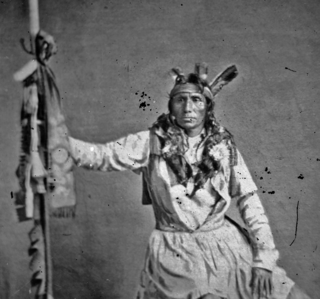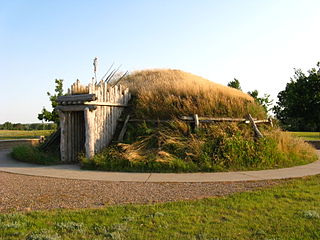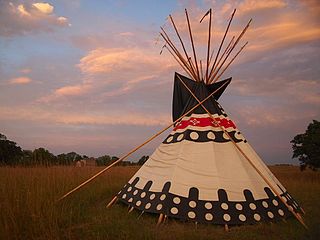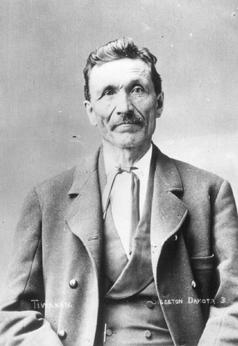Related Research Articles

The Sioux or Oceti Sakowin are groups of Native American tribes and First Nations peoples from the Great Plains of North America. The Sioux have two major linguistic divisions: the Dakota and Lakota peoples. Collectively, they are the Očhéthi Šakówiŋ, or "Seven Council Fires". The term "Sioux", an exonym from a French transcription ("Nadouessioux") of the Ojibwe term "Nadowessi", can refer to any ethnic group within the Great Sioux Nation or to any of the nation's many language dialects.

Faribault is a city in, and the county seat of, Rice County, Minnesota, United States. The population was 23,352 at the 2010 census. Faribault is approximately 50 miles (80 km) south of Minneapolis–Saint Paul.

Wahpeton is a city in Richland County, in southeast North Dakota along the Bois de Sioux River at its confluence with the Otter Tail River, which forms the Red River of the North. Wahpeton is the county seat of Richland County. The population was 8,007 at the 2020 census.

Henry Hastings Sibley was a fur trader with the American Fur Company, the first U.S. Congressional representative for Minnesota Territory, the first governor of the state of Minnesota, and a U.S. military leader in the Dakota War of 1862 and a subsequent expedition into Dakota Territory in 1863.

The Cannon River a tributary of the Mississippi River flows 112 miles (180 km) from Shields Lake near Shieldsville to Red Wing in the U.S. state of Minnesota, where it joins the Mississippi River. It drains a watershed approximately 1460 square miles (3,780 km²) in size. The river flows through the counties of Le Sueur, Rice, Dakota, and Goodhue.

The Minnesota Historical Society (MNHS) is a nonprofit educational and cultural institution dedicated to preserving the history of the U.S. state of Minnesota. It was founded by the territorial legislature in 1849, almost a decade before statehood. The Society is named in the Minnesota Constitution. It is headquartered in the Minnesota History Center in downtown Saint Paul.

Little Crow III was a Mdewakanton Dakota chief who led a faction of the Dakota in a five-week war against the United States in 1862.

The Lower Sioux Agency, or Redwood Agency, was the federal administrative center for the Lower Sioux Indian Reservation in what became Redwood County, Minnesota, United States. It was the site of the Battle of Lower Sioux Agency on August 18, 1862, the first organized battle of the Dakota War of 1862.

The Knife River Indian Villages National Historic Site, which was established in 1974, preserves the historic and archaeological remnants of bands of Hidatsa, Northern Plains Indians, in North Dakota. This area was a major trading and agricultural area. Three villages were known to occupy the Knife area. In general, these three villages are known as Hidatsa villages. Broken down, the individual villages are Awatixa Xi'e, Awatixa and Big Hidatsa village. Awatixa Xi'e is believed to be the oldest village of the three. The Big Hidatsa village was established around 1600.
The Mdewakanton or Mdewakantonwan are one of the sub-tribes of the Isanti (Santee) Dakota (Sioux). Their historic home is Mille Lacs Lake in central Minnesota. Together with the Wahpekute, they form the so-called Upper Council of the Dakota or Santee Sioux. Today their descendants are members of federally recognized tribes in Minnesota, South Dakota and Nebraska of the United States, and First Nations in Manitoba, Canada.

Upper Sioux Agency, was a federal administrative center established in response to treaties with the Dakota people in what became Yellow Medicine County, Minnesota, United States. Located on the Minnesota River south of Granite Falls, Minnesota, the government-run campus of employee housing, warehouses and a manual labor school was destroyed in the Dakota War of 1862. The grave of Chief Walking Iron Mazomani, a leader of the Wahpetonwan Dakota tribes, who was killed during the 1862 Dakota War's Battle of Wood Lake, is here. The site was listed on the National Register of Historic Places in 1970 for having state-level significance under the themes of archaeology, architecture, education, and social history.

The Treaty of Traverse des Sioux was signed on July 23, 1851, at Traverse des Sioux in Minnesota Territory between the United States government and the Upper Dakota Sioux bands. In this land cession treaty, the Sisseton and Wahpeton Dakota bands sold 21 million acres of land in present-day Iowa, Minnesota and South Dakota to the U.S. for $1,665,000.

The Attack at the Lower Sioux Agency was the first organized attack led by Dakota leader Little Crow in Minnesota on August 18, 1862, and is considered the initial engagement of the Dakota War of 1862. It resulted in 13 settler deaths, with seven more killed while fleeing the agency for Fort Ridgely.

Joseph Renville (1779–1846) was an interpreter, translator, expedition guide, Canadian officer in the War of 1812, founder of the Columbia Fur Company, and an important figure in dealings between settlers of European ancestry and Dakota (Sioux) Natives in Minnesota. He contributed to the translation of Christian religious texts into the Dakota language. The hymnal Dakota dowanpi kin, was "composed by J. Renville and sons, and the missionaries of the A.B.C.F.M." and was published in Boston in 1842. Its successor, Dakota Odowan, first published with music in 1879, has been reprinted many times and is in use today.

Gabriel Renville, also known as Ti'wakan, was Chief of the Sisseton Wahpeton Oyate Sioux Tribe from 1866 until his death in 1892. He opposed conflict with the United States during the Dakota War of 1862 and was a driving force within the Dakota Peace Party. Gabrielle Renville's influence and political leadership were critical to the eventual creation of the Lake Traverse Indian Reservation, which lies mainly in present-day South Dakota.

Joseph Renshaw Brown (1805–1870) was an American politician, pioneer, fur trader, newspaper editor, businessman, inventor, speculator, and Indian agent who was prominent in Minnesota and Wisconsin territorial and state politics for over 50 years.

The Shakopee Historic District is a historic district in Shakopee, Minnesota, United States. Stretching along the south bank of the Minnesota River, it encompasses pre-contact Native American habitation and burial sites, a contact-era Dakota village, early Euro-American buildings, and a ferry landing. The property was listed on the National Register of Historic Places in 1972 for its significance in the themes of prehistoric archaeology, aboriginal historical archaeology, non-aboriginal historical archaeology, and architecture.

The Sibley Historic Site is the site of Henry Hastings Sibley's home, who was the regional manager of the American Fur Company and Minnesota's first governor. It is one of the 26 historical sites that are operated by the Minnesota Historical Society. Located in what is now the city of Mendota, the site consists of four limestone buildings and a large lawn area. Three of the buildings are open for touring, including a fur company cold store from 1843 and the 1840 home of fur trader and hotelier Jean-Baptiste Faribault.
Janet D. Spector was an American archaeologist known for her contributions to the archaeology of gender and ethnoarchaeology.

Alexander "Alex" Faribault was an American trading post operator and territorial legislator who helped to found Faribault, Minnesota and was its first postmaster.
References
-
 This article incorporates text from MNopedia, which is licensed under the Creative Commons Attribution-ShareAlike 3.0 Unported License.
This article incorporates text from MNopedia, which is licensed under the Creative Commons Attribution-ShareAlike 3.0 Unported License.
- ↑ Federal and state laws and practices restrict general public access to information regarding the specific location of this resource. In some cases, this is to protect archeological sites from vandalism, while in other cases it is restricted at the request of the owner. See: Knoerl, John; Miller, Diane; Shrimpton, Rebecca H. (1990), Guidelines for Restricting Information about Historic and Prehistoric Resources, National Register Bulletin, National Park Service, U.S. Department of the Interior, OCLC 20706997 .
- ↑ "National Register Information System". National Register of Historic Places . National Park Service. July 9, 2010.
- 1 2 3 4 5 6 7 8 9 10 DeCarlo, Peter J. (January 7, 2016). "Inyan Ceyaka Otunwe". MNopedia. Minnesota Historical Society. Retrieved May 28, 2016.
- ↑ "Inyan Ceyaka Otonwe". Minnesota National Register Properties Database. Minnesota Historical Society. 2009. Retrieved June 19, 2015.
- ↑ Gardner, Denis P. (2004). Minnesota Treasures: Stories Behind the State's Historic Places. Saint Paul, Minn.: Minnesota Historical Society Press. ISBN 978-0873514712.
- ↑ Spector, Janet (1993). What This Awl Means: Feminist Archaeology at a Wahpeton Dakota Village. Minnesota Historical Society Press. ISBN 0-87351-277-4.

